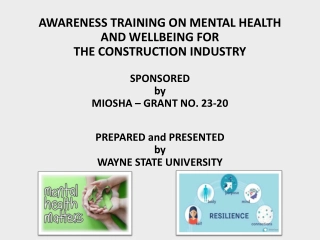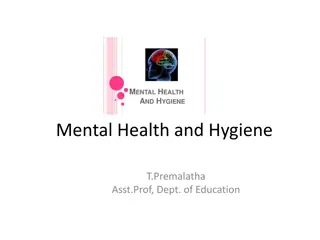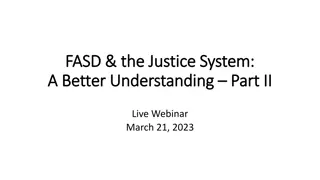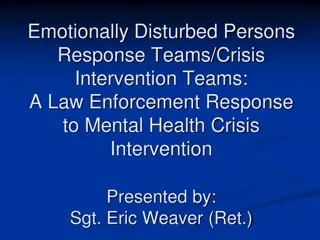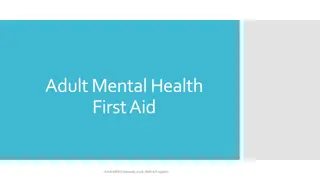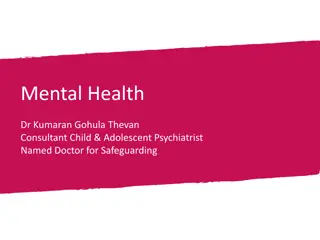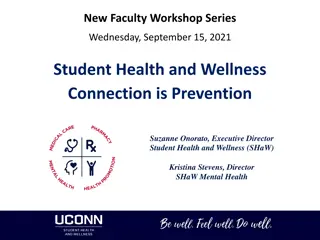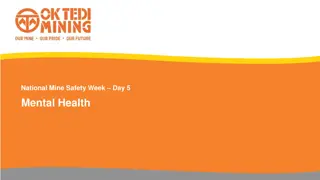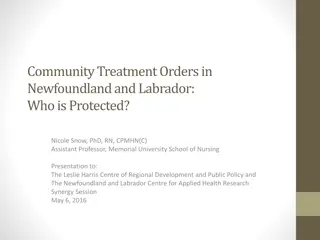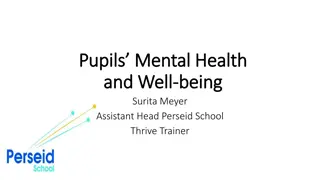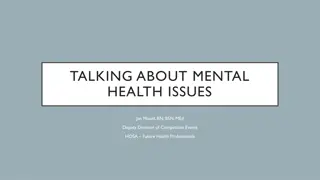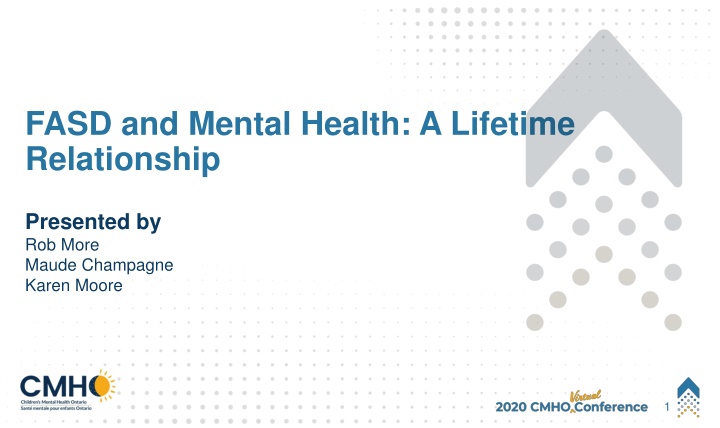
Relationship Between FASD and Mental Health
Explore the lifelong impact of Fetal Alcohol Spectrum Disorder (FASD) on mental health, its prevalence, challenges in diagnosis, and referral processes. Gain insights into the characteristics of FASD individuals and the need for increased awareness and support.
Download Presentation

Please find below an Image/Link to download the presentation.
The content on the website is provided AS IS for your information and personal use only. It may not be sold, licensed, or shared on other websites without obtaining consent from the author. If you encounter any issues during the download, it is possible that the publisher has removed the file from their server.
You are allowed to download the files provided on this website for personal or commercial use, subject to the condition that they are used lawfully. All files are the property of their respective owners.
The content on the website is provided AS IS for your information and personal use only. It may not be sold, licensed, or shared on other websites without obtaining consent from the author.
E N D
Presentation Transcript
FASD and Mental Health: A Lifetime Relationship Presented by Rob More Maude Champagne Karen Moore 1
Thank you to our Sponsor The best mental health and well-being for every child, youth and family. cymh.ca 2
FASD Facts Approximately 4% of the population have FASD or more than twice as prevalent as ASD - https://canfasd.ca/wp-content/uploads/2018/08/Prevalence-1-Issue-Paper-FINAL.pdf Annual Cost in Canada is 9.7 billion dollars. https://jptcp.com/index.php/jptcp/article/view/281 According to the CanFASD database, approximately 13% of children diagnosed with FASD have all three sentinel features. Estimated 90% of individuals with FASD in Ontario currently undiagnosed due to a 68-fold increase needed in diagnostic capacity within Canada. https://www.cmaj.ca/content/cmaj/188/3/191.full.pdf 428 co-morbid conditions associated with FASD with mental health and sensory challenges being the most prevalent. https://pubmed.ncbi.nlm.nih.gov/26777270/ 3
Characteristics of FASD Read Article: https://www.cbc.ca/news/canada/ottawa/sisters-living-with-fasd- point-of-view-1.4970670 They will likely have cognitive impairment including intellectual functioning (IQ), executive functioning (EF), learning and memory, language and communication, visual-spatial abilities, motor function, attention and activity, academic achievement Social, adaptive and emotional skills will also likely experience uneven development. All of this means they will likely experience difficulty learning from mistakes, anticipating consequences and maintaining emotional and impulse control. They tend to have extreme safety responses exhibiting fight, flight, freeze, fawn, and faint when overwhelmed. https://pubmed.ncbi.nlm.nih.gov/18825524/ 4
Diagnosis Process Only medical practitioner using 2015 Canadian Guidelines can diagnose https://www.cmaj.ca/content/cmaj/188/3/191.full.pdf Requires an OT assessment, SLP assessment, Psychological assessment, Social history and Facial assessment. Current waitlist is 5-6 years or $5000-$7000 privately. There are currently 14 publicly funded and 1 private clinic in Ontario. However, only CHEO in Ottawa and NorWest in Thunder Bay don t have defined catchment areas. https://canfasd.ca/wp-content/uploads/2018/06/ON-FASD- English-FAQ-card-2018-06-25.pdf Largest challenge is there is currently no OHIP code diagnosing FASD which impacts tracking purposes, establishing best practices and increasing capacity. 5
Referral Process MCCSS through Coordinating Service Agencies hired 50+ FASD workers two years ago. They serve as social workers, system navigators and point of contacts for referrals. There will be someone assigned to your area. Please reach out to your local worker to find out where diagnostic referrals should go. https://docs.google.com/document/d/1sTpXYpp9GXTQPoZnzAZl-wnDY- Qk9SKWlpJsMv_on4g/edit To access this worker, MCCSS established any professional who in their judgment suspects someone may have FASD, they may refer to the FASD worker. Individuals and/or their caregivers can also self-refer. 6
Protective Factors for Positive Outcomes Read Article: https://canfasd.ca/wp-content/uploads/2019/11/Final-Towards- Healthy-Outcomes-Document-with-links.pdf This is the document you will want to read, particularly p.20-22 around the importance of collaboration within organizational capacity. British Columbia and Alberta just concluded their ten-year studies on the effectiveness of their provincial strategies in 2019. This document summarizes the findings from those studies. Acknowledgement must be given to CanFASD (Canadian FASD Research Network) who maintain the national database on FASD prevalence, policy development, online courses, and a library that contains all Canadian FASD research studies. Kids Brain Health Network is also a wonderful research partner. 7
Summary The traditional life trajectory of someone with FASD is full of trauma, shame, stigma and negative outcomes resulting in a short life expectancy. However, the initial step to positive outcomes is diagnosis and support for their entire network. We also know 90% of children with FASD will have mental health challenges by age 18. As a mental health practitioner, you are uniquely positioned to help identify and refer a child with FASD and their caregiver more than any other person they will meet. The Rural FASD Support Network intentionally focused on our local SLP s and Children Mental Health organizations to help bring awareness and collaboration between our 120 families and 154 children with FASD to have the largest possible impact on their lives. 8
FASD and Trauma According to CanFASD's National Database, most people diagnosed with FASD don t live with their biological parent, more than 15% of people diagnosed with FASD have attachment difficulties and more than 40% have trauma. Among patients with FASD, the most common childhood adversity experiences are: neglect (87%), substance abuse by parents (85%), parental separation or divorce (50%) and physical abuse (50%) Kambeitz et al. (2019). FASD and developmental trauma have very similar symptoms. 9
Intervention and FASD Lifelong support for a permanent condition 10
Fetal alcohol spectrum disorder (FASD): A beginner s guide for mental health professionals Read: https://www.pulsus.com/scholarly-articles/fetal-alcohol- spectrum-disorder-fasd-a-beginners-guide-for-mental-health- professionals-4201.html Memory Problems Suggestibility Confabulation Adaptive and Functioning skills 11
DDP and FASD: My thesis FASD and developmental trauma: a similar experience? DDP and FASD: a good fit? Rethinking parenting to the child s cognitive impairments: Parents experienced DDP as a very different approach to anything they had tried before. This fits with DDP s development, where Dan Hughes identified that a different approach was required for treatment of developmental trauma (Hughes, 2014). Traditional behavioral approaches are not considered to accommodate the neurodevelopmental effects of maltreatment (Wingfield & Gurney- Smith, 2018, p.13-14). 12
Dyadic Therapy To accommodate cognitive impairments To model intersubjective communication To support the parent in their role To prioritize the parent-child relationship 13
So what does this mean for me as a mental health professional? Keep learning about FASD https://canfasd.ca/ and https://www.fasdinfotsaf.ca/en/ It s not always FASD and sometimes it is---be aware of your own biases and assumptions (and possibly your agency biases or assumptions) about FASD---who are the birth parents? What does FASD look like in children/youth? https://ken.childrenshealthcarecanada.ca/xwiki/bin/view/FASDScreeningToolkit/National +Screening+Tool+Kit+for+Children+and+Youth+Identified+and+Potentially+Affected+by+ FASD Remember the barriers to diagnosis----many may have FASD but don t have the diagnosis of FASD https://canfasd.ca/wp-content/uploads/publications/FASD-Clinic-Process.pdf 15
And Still More Understand key concepts of FASD so you can see them when they occur--- confabulation, patterns of knowing and then not knowing, fight, flight, freeze, fawn or faint! https://youtu.be/NdANbWlpJm4 Looking at how to support parents---in the unpredictable, often unrecognized world of FASD https://canfasd.ca/wp-content/uploads/publications/CanFASD- Caregiver-Guide-to-Diagnosis-Jan2020-interactive.pdf Review your intake, assessment and intervention strategies to ensure that you are creating an environment where FASD can be explored, talked about, supported https://canfasd.ca/wp-content/uploads/2018/09/Best- Practices_June12018.pdf 16
And Finally Look at the way you do your work to incorporate the sensory, relational and environmental needs of someone with possible FASD i.e. length of sessions/interventions, repetitive, remembering confabulation and information accessibility, tolerance needs https://youtu.be/U4FlZrxE4AQ Helping to create interventions and support that recognize the inconsistent development pattern this includes helping parents understand how to parent from this perspective--- decoding behavior based on developmental age in each developmental stage http://www.knowfasd.ca/ Create (or continue to create) partnerships with community resources to build a team for the child/youth/family---education, police, FASD key workers, parent support, peer support, recreation, work environments https://canfasd.ca/topics/interventions/best- practices/ 17
Exit Poll We now ask you to participate in the following poll to give us feedback as to the effectiveness of our presentation and what next step and future presentations we should explore. 18
Short Answer Questions We would ask you to use the chat function now to answer the following questions: 1. Based on this presentation, what areas of need if any have you identified within your practice and/or organization? 2. Have you identified a next step for changing your practice, processes and methods and if so, what will it be? 3. What other topics on FASD and Mental Health would you like to learn about? 19
Innovating and Advancing Child and Youth Mental Health November 23 to December 4 Sponsored by

